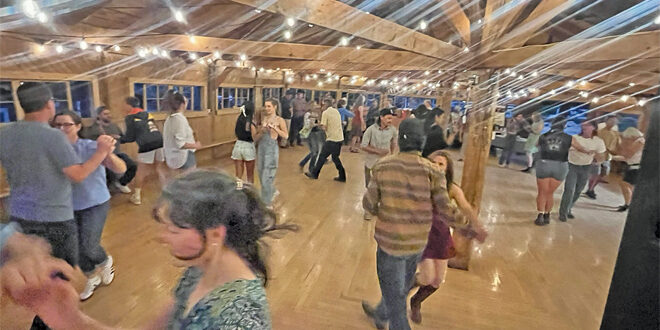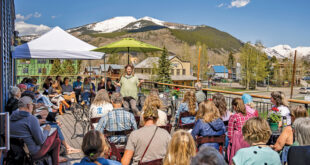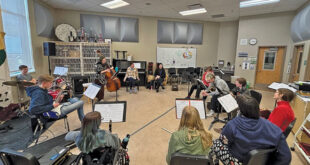– The Pavilion Dance Hall Series brings back the community –
By TONI M. TODD
In the early 1980s, Wang Chung waxed nostalgic about Dance Hall Days, considered long-gone even then. Today, in the Gunnison Valley, Darcie Perkins and Lizzy Plotkin, with a little help from their friends, have done something more than reminisce about the good ol’ days; they’ve brought them back.
To hear Perkins tell it, the summerAlmont Pavilion Dance Series is an idea whose time has come, but also an idea that’s nearly as old as Crested Butte itself.
“It’s nothing novel, and it’s nothing new. In fact, it’s very old,” she says, “but it disappeared.” Then, this summer, it reappeared, more successfully than its organizers imagined.
“There were a couple of fortuitous things that happened at the same time that gave me the nudge,” says Perkins of the idea that struck her to revive community dances in the Gunnison Valley. The first was Polly Oberosler’s book, The Low Down From the High Up, which Perkins was reading on a recent trip to see her son Tanner, now attending Montana State in Bozeman. “Polly’s grandfather built that building,” she says, referring to the Almont Pavilion, an open-air structure designed for dancing, now used for assorted gatherings—reunions, weddings, etc. —and owned by Three Rivers Resort.
At just over 100 years old, it’s still standing, with a maple floor begging to feel the rhythm of fleet-footed dancers once again. In its early decades, the Pavilion kept the rain off folks as they shimmied, twirled and dipped the night away. “She [Oberosler] talks about the culture, not just that it was dance and music, but how it was a melting pot of diversity,” says Perkins. “It was people from all over the world that were mining here, bringing their style of music.”
“They would all pile in someone’s car and make the drive to Almont [from Crested Butte] over rough and unpaved roads after working a 12-hour shift in the mine,” says Oberosler in her book. “Attending one of these dances at the Pavilion was something everyone looked forward to, the highlight of the summer for many.” Oberosler’s description of how organizers managed the Pavilion through the roaring ‘20s and Prohibition was especially poignant for Perkins. Folks were encouraged not to drink, she says, but if they felt they must, they were asked to do so discreetly outside. In other words, drink ‘em if ya got ‘em, but don’t bring alcohol into the dance hall.
The second fortuitous event was Perkins’s visit to Bozeman. Tanner, who has taken up swing dancing, introduced her to a favorite honky tonk. “What I witnessed there was remarkable. He’s of an age now that he can order a beer at the bar, but that beer sat for an hour and a half, half-drunk because he was too busy dancing. Nobody was on their phones. There were multiple generations of people. He danced with his mom, he danced with women my age. People were teaching each other stuff. It was fun and interactive and engaging.”
Perkins says her younger son is also “doing swing dancing in college, finding community there.” She reflected on our modern mountain culture and the challenges she faced as a parent when her boys were growing up. “I struggled with raising my sons in Crested Butte because most of the activities that high school students engaged in outside of organized activities revolved around consumption. When my son would go to high school dances, most of his peers would leave before it even started, and it was about the after-party. What I saw in Bozeman was a flashback to when I was growing up. You actually danced with your friends.”
The combined experience of reading Oberosler’s book and visiting Tanner prompted her to call a friend, Kari Commerford, director of Gunnison County Juvenile Services, to see if the Gunnison County Substance Abuse Prevention Project (GCSAPP) would be interested in sponsoring a summer dance series. “She knows that I have really struggled as a parent, and she knows that I’ve always wanted to do something that was not incredibly uncool.” She also contacted Jen Bickford, manager at Three Rivers Resort, to see if there might be a way to use the Pavilion. “She said ‘You can have Wednesday nights, and I’ll donate it if you organize it.’” The Almont Pavilion seemed to be that perfect midway location, the ideal place to bring both ends of the valley together. As Perkins’s dream of a community dance hall with live music began to materialize, she realized, “I don’t know how to dance, and I don’t play music. So the next person I went to was Lizzie Plotkin. Honestly, I have done nothing since. Lizzie has done it all.”
Plotkin is not only a professional musician but has musical connections throughout the Gunnison Valley.
“Darcie and I had a grand vision of what we wanted to happen,” she says. The biggest challenge was getting everyone involved — musicians, volunteers, dance teachers – on the same page and part of that vision. It took a lot of intention and attention to detail, explanation, talking it all out so that there wasn’t anything left to question.”
One of the most important things, says Plotkin, was to teach musicians the difference between playing live at a regular gig and playing at a dance hall.
“It’s less of a performance,” Plotkin says. “Your main goal is getting folks moving and keeping them going. When it’s time for a slow song, you know it and when it’s time for another rockin’ number, the dancers will show you that, too. For me, it’s more fun because there’s less ego involved—as long as the music is groovin’ and the people are moving’’ that’s what matters. You can just sink into the song with the band, and watch the dancers go.”
Plotkin’s knowledge of local musicians helped her choose the initial lineup for this past summer. “I booked the singers and bands based on the idea that these local acts know how to play traditional music meant for swing dance or country partner dance,” she says. “Then, each week, I coordinated with Micheala and Michael Steed, the dance teachers, to tell them what style of dance fits best with the band’s music. Lots of folks show up new to dancing so it’s great to give them a foundation of what will work for the night of music. Some other dancers are good and have tons of experience. I found that everyone was able to dance to the bands that we booked. It’s been a nice combination of learner and experienced dancers, and everyone seems to have a great time.”
The original plan was to charge a small fee at the door. “We figured the band would get $60, the dance teachers would get $20,” says Perkins. “Then, when all this came together, and we knew it was going to happen, Kari [Commerford] chimed back, ‘How much would it cost to make this free and remove the barrier?’” In addition to GCSAPP, sponsors include the Gunnison Consortium (Grasp), an organization dedicated to helping people sustain healthy lifestyles and battling substance use disorder, and the newly formed Gunnison Valley Music Association, a nonprofit dedicated to establishing the Gunnison Valley as the singer-songwriter capital of the Rocky Mountains. The GVMA acts as the umbrella nonprofit so that folks can donate to the project. They also provide the sound system.
“And Mark Schumacher,” adds Perkins. “As owner of Three Rivers Resort, he is the one who gave the green light for this.”
Plotkin not only finds and books the musicians; she’s the one setting up the system each week to make the bands sound great.
Indeed, the Pavilion Dance Series has been a labor of love for Plotkin, who put in many hours putting the pieces of this venture together.
“I am a nostalgic person,” she says. “I love the idea that 100 years ago, people in the Gunnison Valley built and maintained this dance hall and spent their summer nights dancing to live music, just like we’re doing. It feels like just the right kind of fun and the kind of thing I am happy my kid will get to experience in Almont as he grows up here. Also, we have many talented musicians who can play this kind of music. So, it was a good excuse to showcase that. I am passionate about traditional music and dance in America because it’s something we can call our own. Maintaining traditions like dances keeps us connected to our past and provides a good opportunity to stay connected to our neighbors in the present and future.”
Perkins and Plotkin have been so pleased with the success of the inaugural Almont Pavilion Dance Series that they’re already looking toward next year, hoping to expand the series to last a few weeks longer in in summer. They’re also looking for a possible off-season venue, with the dream of keeping our community dancing throughout the fall, winter and springtime, too.
 The Crested Butte News Serving the Gunnison Valley since 1999
The Crested Butte News Serving the Gunnison Valley since 1999



